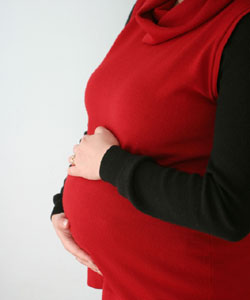Should You be Concern About Using Hair Dye During Pregnancy?
I strongly recommend not doing any chemical processes during the first three months of pregnancy for both safety reasons and your potential sensitivity to the chemicals in color product. Lets take a look at possible concerns:

According to Organization of Teratology Information Services (OTIS), "The amount of an exposure, the timing during the pregnancy and frequency of use may be important factors when thinking about hair treatments in pregnancy".
After the first three months of pregnancy, I recommend treating your hair in a ventilated space to minimize your exposure to the chemicals.
And although the collected data and research are limited but they say that "hair treatment in pregnancy unlikely to be of concern." You can download and view this article from OTIS. (This article is in Pdf format). This document discuss different types of hair treatments and answer to most common questions about hair color and pregnancy.
Allergy Concern
Some people have allergic reactions to hair hair color. It can happen to anyone - even if you've colored before. Some women have been known to develop an allergic reaction to a hair color that they have successfully used several times in the past. Always ask your stylist or colorist for an allergy patch test 48 hours before each color treatment.
Some permanent hair color preparations or packages, particularly those containing parapheneylenediamine also known as PPD, carry a warning on the packaging to the effect that a patch test should be done prior to use of the dye. Parapheneylenediamine is the substance that is responsible for most allergy cases related to dye.
If you color your hair at home, then test a little dye on your skin 48 hours before application and see if you have any reaction. If you notice that your skin is irritated after contact with hair dye, then stop the treatment and see your doctor to find out if you have an allergy or sensitivity.
Other classical sign for allergy includes itchy skin rashes, reddish eyes, swelling of the eyelids, runny nose, sneezing, a blocked nose, swelling of the lips and mouth
For more advice on hair color related to permanent hair dye and allergy, paraphenylenediamine and how to use a patch test visit www.dermnetz.org or see a dermatologist for advice.
If you have allergy to traditional hair colors then perhaps its time to change to newly-developed organic hair colors.
Concern with Cancer?
Hair dyes, and permanent hair colors has been under researches microscope for long time. The latest research provide some evidence tying hair colors to the risk of blood-related cancers such as leukemia and multiple myeloma. (American Journal of Epidemiology 01 July 2004, vol. 160, no. 1, pp. 19-25(7))
These findings suggest hair dyes (specially earlier dye formulations used before 1980) could be a potential risk factor for leukemia and other blood-related cancers.
However there is no evidence at all that semi-permanent or temporary hair dyes are linked with these diseases. There have been many studies investigating hair color and other types of cancer and these have also produced conflicting results.
cancer studies Includes:
- American Cancer Society, 1982 Did not find any association between bladder cancer and hair dye use.
- University of Southern California, 12 Jan. 2001 Reported that long-term (15 years) and regular use of permanent hair dye (3 times per month) could increase the risk of developing bladder cancer.
- Department of Epidemiology and Public Health, 2004 Reported that increased risk of non-Hodgkin's lymphoma (a type of blood cancer) has been observed in use of hair coloring products before 1980 and no disease among women who started using hair-coloring products in 1980 or later.
Studies also showed that those used darker permanent hair-coloring products for more than 25 years doubled their risk of non-Hodgkin's lymphoma. American Journal of Epidemiology 15 Jan. 2004 Am. J. Epidemiol. 2004 159: 148-154.

